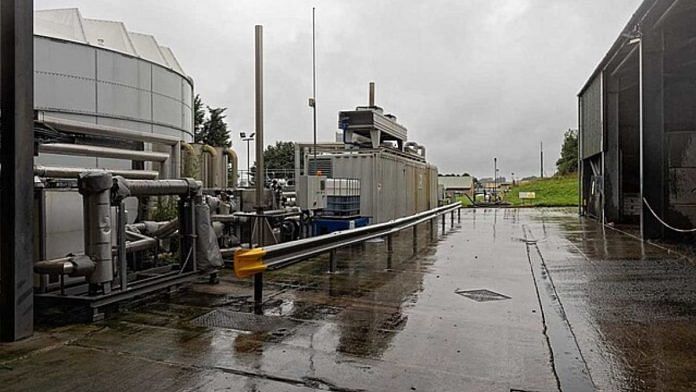A prolonged and record-breaking heatwave has led to a water crisis in Delhi, forcing authorities to crack down on water wastage and impose fines. This is not the first Indian city this year to face water scarcity; Bengaluru and Pune have already borne the brunt of it.
Several Indian cities could face water shortages, with above-normal temperatures and several heatwave days experienced this summer. In southern India alone, water reservoirs were at 15 per cent of their capacity in early May, below the average of the last 10 years.
India has been witnessing a steady decline in its freshwater resources. Moreover, NITI Aayog estimates that the national water demand will be twice the available supply by 2030. Rapidly growing urban centres will be the first to bear the brunt of this looming threat of water scarcity. So, municipal bodies will need to be the first line of defence against it. But there is a largely untapped water source that can help.
Almost 80 per cent of the water supplied to city dwellers is later released after use from kitchens, toilets, bathing, and washing activities. This is referred to as domestic wastewater or used water. According to an analysis by the Council on Energy, Environment and Water (CEEW), Indian cities will generate over 30 billion cubic metres of domestically used water by 2030.
When safely treated and reused, it is a highly valuable resource that can reduce the pressure on existing freshwater resources and improve the quality of rivers and aquifers. Treated used water can be reused for numerous applications such as in parks and gardens, irrigation, industries, construction, fire hydrants, and road cleaning.
Reality of used water management in Indian cities
In 2021, Indian cities generated over 72,000 million litres of used water (domestic sewage) per day, of which only 28 per cent was actually treated. Recently, CEEW has developed a first-of-its-kind municipal index to evaluate the performance of urban local bodies (ULBs) in used water management. ULBs, being the custodians of all forms of water management at the city level, are the focus of the index.
Over 500 ULBs (such as municipal corporations and municipal councils) from 10 Indian states that have treated water reuse policies in place were selected. These states are Andhra Pradesh, Chhattisgarh, Gujarat, Haryana, Jharkhand, Karnataka, Madhya Pradesh, Punjab, Rajasthan, and West Bengal. The ULBs were evaluated based on a set of parameters related to finance, infrastructure, efficiency, governance, and data and information.
We found that Surat was the top-ranking city on the index, with Bengaluru coming in at a close second. These two ULBs have defined city-level targets and priority users for the reuse of treated water.
Bengaluru, which has been in the news of late due to its water crisis, is taking steps to combat the rising water demand and water stress by reusing treated water for non-potable purposes. The city reuses about 50 per cent of its treated water for industrial purposes, construction activities, horticulture, and landscaping.
Nevertheless, it is important to note that no ULB has achieved full scores on the index, indicating significant room for improvement across India. One reason is the lack of financial planning—90 per cent of these urban local bodies have low investment priorities and cost recovery for operating and maintaining the wastewater infrastructure.
Surat Municipal Corporation stands out: The ULB directed over 92 per cent of its consolidated investment towards sewage and septage management from 2015 to 2020. It is also recovering the cost of used water treatment by selling treated water to manufacturing industries for reuse. Other local bodies can learn from this.
Also read: Maharashtra govt’s efforts to tackle drought inadequate; will have to resort to struggle: Pawar
What can India’s ULBs do?
We found that 414 out of the 503 ULBs assessed don’t reuse any of their treated water (which is discharged into local water bodies) or do not have any functional treatment infrastructure. The formulation and adoption of long-term reuse plans at the ULB level, with clear reuse targets and provisions for feasible business models, is key for all states.
First, access to reliable and current data is essential to formulate new plans and water reuse policies and update the existing ones. However, over 65 per cent of ULBs assessed struggle with the public availability of municipal data. CEEW’s municipal index sets the baseline for over 500 ULBs, providing a comprehensive framework for them to maintain and strengthen databases on used water management. This can facilitate decision-making by providing ULBs with information on areas that require improvement.
Second, ULB-level water reuse plans can leverage initiatives of existing national missions, such as AMRUT 2.0 and National Mission for Clean Ganga (NMCG), that focus on water security and pollution abatement through effective used water management. For instance, treated water reuse projects can be implemented under the urban river management plans being prepared for river cities by NMCG.
Third, timely evaluations can promote cross-learning and healthy competition among cities to address water stress. For instance, cities can learn from the business models of Vishakhapatnam and Udaipur, wherein bulk private users like industries are roped in to finance advanced used water treatment and maximise reuse.
Water is a critical link for a circular and sustainable economy. Reusing treated water to its full potential will be crucial in the future, especially for cities such as Bengaluru, Hyderabad, Delhi and others that face water stress during summer months frequently.
For Indian cities to continue to be engines of growth and resilience, urban local bodies are important drivers that need to be empowered. And water flows through all.
Saiba Gupta is a Programme Associate and Nitin Bassi is a Senior Programme Lead at the Council on Energy, Environment and Water (CEEW). Views are personal.
(Edited by Prasanna Bachchhav)



